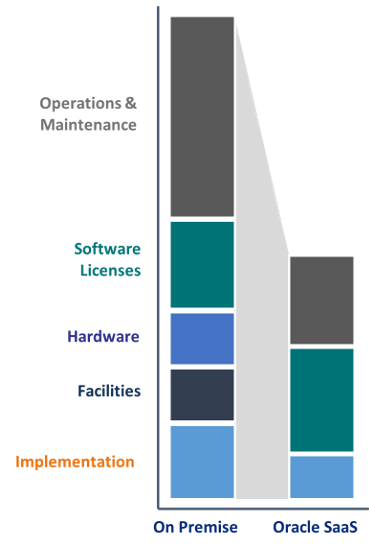Exploring the advantages of Moving from JD Edwards to Oracle SaaS Cloud
To adapt to the ever-changing industry standards, technological advancements, and customer expectations, an increasing number of companies are seeking to modernize their information technology (IT) stacks. This involves migrating their workloads and applications to the cloud.
Notably, enterprise resource planning (ERP) applications like Oracle JD Edwards are gradually shifting to the Oracle SaaS cloud, unlocking a host of new capabilities and advantages, and enabling enhanced access and sharing of information—also, ease of access to the ERP application from any location and device via the internet.
This is driven by the key trends of recognition of data’s pivotal role in decision-making and the need for efficient operations in decentralized work environments. Cloud solutions are garnering attention across organizations owing to their lower TCO compared to on-premises setup, better security, automatic updates, and reduced downtime.
Why Oracle SaaS Cloud?
Key factors that business consider before taking the final decision are listed below:
Mitigated risk and simplified IT operations
A significant number of customers who were interviewed for migrating from on-premise deployments to Oracle SaaS mentioned the substantial reduction in associated costs as the driving factor. This included eliminating expenses like server procurement, maintenance, electricity costs, and dedicated personnel for system management, along with managing custom feature development, reporting, and updates.
Technology debt is often caused by delays in version updates owing to various complexities involved in managing updates across multiple solutions. This acts as a roadblock for modernization efforts, creating an inventory of outdated systems.
Transitioning to Oracle cloud ERP helps reduce financial commitments and allows organizations to reshape IT teams and focus on value-added tasks with reduced administrative responsibilities. Additionally, owing to the migration, the application security and performance management responsibilities are transferred to Oracle, helping in leveraging the top-tier cloud security measures. This further ensures enhanced security and availability in comparison to legacy on-premises systems.
Enhanced business agility
Embracing cloud technology helps provide a noticeable boost in responsiveness and business agility.
The adoption of cloud technology brings forth a notable boost in responsiveness and overall business agility. Oracle Cloud ERP empowers customers to seamlessly access ERP data from any location through web interfaces or mobile applications, ensuring real-time access to current data.
What sets it apart is the capability for users to independently create new dashboards or reports within Oracle Cloud ERP, eliminating the need to submit requests to the IT department. This shift leads to streamlined operations.
Streamlined business applications
The traditional method of manually integrating various point solutions is marked by inefficiency, high costs, and the potential for gaps in visibility, leading to overlooked insights and misunderstood operations.
With the help of a platform-oriented approach, it reduces inefficiency, cuts costs, and improves cross-departmental analyses. While this approach introduces challenges such as data indexing and access governance, it facilitates more advanced, cross-departmental analyses, enhances top-level visibility into the business’s state, and diminishes overall system complexity, resulting in cost reductions for IT.
The inclination towards adopting a platform-based approach in the cloud is prevalent among many customers, and solutions like Oracle Cloud ERP are well-suited for facilitating this type of migration.
Roadblocks for migrating JD Edwards to Oracle Cloud
Businesses are rapidly considering migrating JD Edwards to oracle cloud but often wonder about the various challenges that they might come across. Data migration complexities, ensuring compatibility with existing systems, adopt and integrate the existing customizations, getting the employees acquainted with the new processes all within minimum downtime during the migration process.
Customization as per the existing processes, effectively managing the change and optimizing the cost are important factors that influence the final decision-making process.
Discover the key benefits of migrating from JD Edwards to Oracle Cloud
While considering transitioning from Oracle JD Edwards to Oracle Cloud, it is important that businesses seek to explore the advantages that seek innovation and efficiency. Here are some of the primary benefits that help businesses make a strategic choice:

Figure 1: Cost comparison between JDE and Oracle SaaS
- Cost-effectiveness
Shifting from an on-premises legacy system to Oracle’s cloud platform significantly reduces costs for customers by eliminating the need for on-premises hardware and related IT resources. This shift streamlines operational expenses as customers don’t have to manage internal applications, oversee system updates, and integrate with legacy systems. Furthermore, the reduced customer-side responsibilities, including security management, contribute to additional cost savings through decreased headcount or strategic redeployment.
- Enhanced collaboration and accessible data
Oracle Cloud ERP revolutionizes information sharing by breaking down departmental silos and unifying databases. The integration provides cross-departmental visibility into customer data, helping to enable sales, service, and marketing teams to collaborate effectively. The system provides a personalized customer experience and fosters productive interactions. Also, the inclusive data system facilitates comprehensive analytics and cross-departmental reporting.
- Elevated data-driven decision-making
Oracle Cloud ERP efficiently centralizes data for customized reporting through user-friendly applications, reducing the need for expensive training and dedicated personnel. Users with access to consolidated data generate advanced reports and make well-informed, data-driven decisions that propel business transformations. Oracle’s ongoing investments in new functionalities and infrastructure developments help customers derive long-term value from their Cloud ERP deployments.
- Amplified user productivity
The accessibility of Oracle’s solution via the internet empowers users to connect to the platform and access company information seamlessly using mobile devices or any computer with an internet connection. Operations teams save time on report generation and data searches, as information is readily available on Oracle Cloud ERP, eliminating the time-consuming process of querying data through a dedicated system. Additionally, the IT resources previously dedicated to managing security, implementing updates, and conducting routine system maintenance can be redirected to more value-added tasks.
As a trusted service partner for Oracle JD Edwards (JDE), we at LTIMindtree help clients reimagine JDE to migrate significant workload to the cloud, integrate JDE with SaaS applications and help accelerate their digital journey. We embrace the limitless possibilities of technology with comprehensive IT services and solutions, that help empower your business to thrive in this digital age. Experience the benefits of LTIMindtree’s solution and take control of your inventory management today.
For more information, write to us at oraclemarketing@ltimindtree.com.
Latest Blogs
Core banking platforms like Temenos Transact, FIS® Systematics, Fiserv DNA, Thought Machine,…
We are at a turning point for healthcare. The complexity of healthcare systems, strict regulations,…
Clinical trials evaluate the efficacy and safety of a new drug before it comes into the market.…
Introduction In the upstream oil and gas industry, drilling each well is a high-cost, high-risk…




